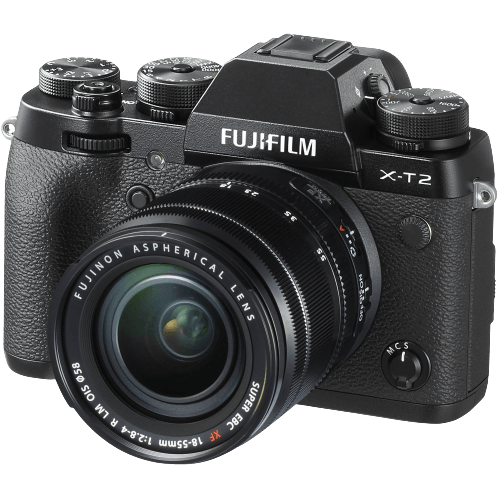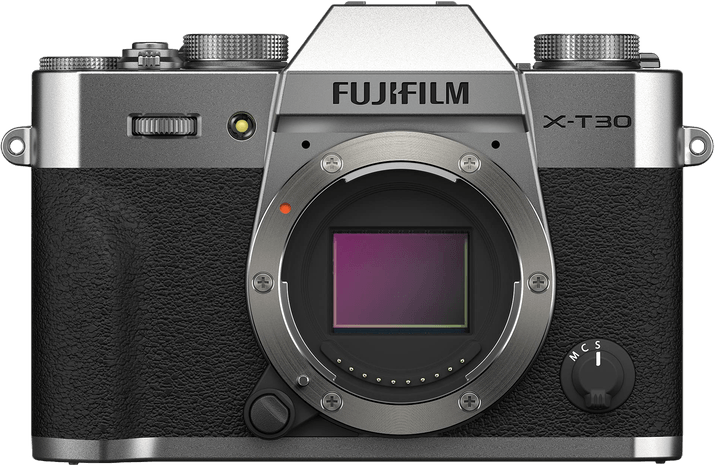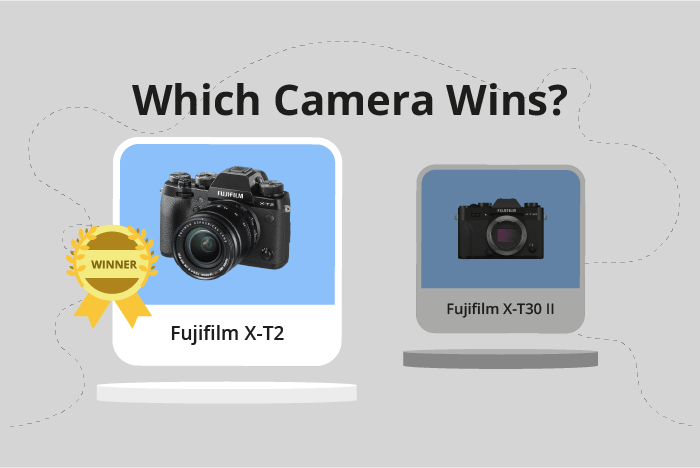Fujifilm X-T2 vs X-T30 II Comparison
Fujifilm X-T2

Fujifilm X-T30 II

The Fujifilm X-T2 emerges as the winner with a score of 68/100, outperforming the Fujifilm X-T30 II by 3 points. Both cameras share key features, such as being mirrorless and having similar camera dimensions. However, the X-T2, released in 2016 with a launch price of $1599, has a larger size (133 x 92 x 49mm) and is heavier (507g / 1.12lbs) than the X-T30 II.
The X-T2’s higher score suggests superior performance in some aspects. On the other hand, the X-T30 II, launched in 2021 with a more affordable price of $899, offers a compact and lightweight design (118 x 83 x 47mm, 383g / 0.84lbs). This makes it a more portable option for photographers on the go.
To sum up, the Fujifilm X-T2 takes the lead with a better score, while the X-T30 II presents itself as a budget-friendly and portable alternative.
Fujifilm X-T2 vs X-T30 II Overview and Optics
The Fujifilm X-T30 II narrowly wins in the optics comparison with a score of 67/100, while the Fujifilm X-T2 scores 66/100. Both cameras share several specifications, such as having a CMOS sensor, APS-C sensor size, Fujifilm X lens mount, and no image stabilization. Furthermore, neither camera has a DXOMARK score, as the organization does not score Fujifilm cameras.
The X-T30 II outperforms the X-T2 in some key areas. It has a higher resolution with 26 megapixels compared to the X-T2’s 24 megapixels, allowing for more detailed images. Additionally, the X-T30 II boasts a superior shooting speed of 30 frames per second, doubling the X-T2’s 14 frames per second. This faster shooting speed enables the X-T30 II to capture fast-moving subjects more effectively. The X-T30 II also has an upgraded processor, the X-Processor 4, which enhances the camera’s performance and image processing capabilities.
On the other hand, the Fujifilm X-T2 has its own advantages. Despite having a lower resolution and slower shooting speed, it still produces high-quality images, thanks to its 24-megapixel sensor and X-Processor Pro. Although it does not outperform the X-T30 II in any specific area, it remains a reliable choice for photography enthusiasts.
To sum up, the Fujifilm X-T30 II takes the lead in this optics comparison due to its higher resolution, faster shooting speed, and advanced processor. However, the Fujifilm X-T2 is not far behind and remains a solid option for those who prioritize image quality and performance.
Fujifilm X-T2 vs X-T30 II Video Performance
The Fujifilm X-T30 II takes the lead in video capabilities with a score of 91/100, outperforming the Fujifilm X-T2, which scored 83/100. Both cameras share some common specifications, such as 4K video resolution and built-in time-lapse functionality. However, the X-T30 II surpasses the X-T2 in certain aspects, making it the superior choice for videographers.
One significant advantage of the X-T30 II over the X-T2 is its higher maximum video dimensions of 4096 x 2160, compared to the X-T2’s 3840 x 2160. This difference allows the X-T30 II to capture more detailed and higher quality video footage. Additionally, the X-T30 II boasts a maximum video frame rate of 120fps, doubling the X-T2’s 60fps. This higher frame rate enables the X-T30 II to produce smoother slow-motion videos and better overall footage.
Despite the X-T2’s lower score, it still offers strong video capabilities. Its 4K video resolution and built-in time-lapse functionality make it a solid choice for casual videographers or those on a budget. However, the X-T30 II’s superior video dimensions and frame rate make it the better option for those seeking professional-quality footage.
When comparing the Fujifilm X-T2 and X-T30 II, it is clear that the X-T30 II is the better choice for videographers due to its higher video score and superior specifications. The X-T2 remains a viable option for those who prioritize affordability or do not require the advanced video features of the X-T30 II. Ultimately, the Fujifilm X-T30 II stands out as the superior camera for video capabilities.
Fujifilm X-T2 vs X-T30 II Features and Benefits
The Fujifilm X-T2 and X-T30 II both have a feature score of 70/100. Despite having the same score, each camera has its own advantages and disadvantages in terms of features.
Both cameras share several common specifications, such as a 3-inch screen size, 1,040,000-dot screen resolution, flip screen, absence of GPS, and the presence of Wi-Fi and Bluetooth connectivity. These similarities make both cameras suitable for various photography needs and provide users with essential features expected from modern cameras.
The Fujifilm X-T30 II has an advantage over the X-T2 due to its touchscreen capability. This feature allows for more intuitive and efficient navigation through menus and settings, making it easier for photographers to adjust their camera on-the-go. The touchscreen also contributes to a more enjoyable user experience.
On the other hand, the Fujifilm X-T2 does not offer any significant advantages over the X-T30 II, as both cameras share the same feature score and most specifications. The absence of a touchscreen on the X-T2 may be a disadvantage for some users, but it does not necessarily make the camera inferior.
Considering the features of both cameras, the Fujifilm X-T30 II stands out as the better option due to its touchscreen capability. This additional feature enhances the user experience and makes it easier to navigate the camera’s settings. The Fujifilm X-T2, while sharing many of the same specifications, lacks this beneficial feature. Therefore, for those seeking a camera with a more user-friendly interface, the Fujifilm X-T30 II is the preferable choice.
Fujifilm X-T2 vs X-T30 II Storage and Battery
The Fujifilm X-T2 outperforms the Fujifilm X-T30 II in storage and battery with a score of 68/100 compared to 35/100. Both cameras have USB charging and use the NP-W126S battery type. However, the X-T2 has advantages that contribute to its higher score.
The X-T2 boasts two memory card slots, while the X-T30 II has only one. Additionally, the X-T2 accepts SD, SDHC, and SDXC memory cards with UHS-II compatibility, enabling faster data transfer. In contrast, the X-T30 II is compatible with UHS-I memory cards, which offer slower transfer speeds.
Despite its lower score, the X-T30 II has a slightly longer battery life of 380 shots, compared to the X-T2’s 340 shots. This advantage may be beneficial for photographers who prioritize longer shooting sessions.
Taking these factors into account, the Fujifilm X-T2 offers superior storage capabilities and faster memory card compatibility, while the X-T30 II provides marginally better battery life.
Fujifilm X-T2 vs X-T30 II – Our Verdict
Are you still undecided about which camera is right for you? Have a look at these popular comparisons that feature the Fujifilm X-T2 or the Fujifilm X-T30 II:

